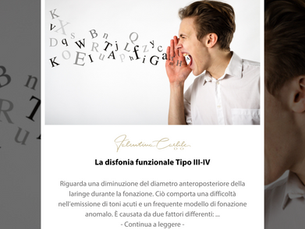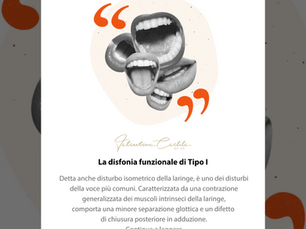top of page
Valentina Carlile
Blog
In my daily professional practice, I often talk to colleagues and answer patients' questions on topics relating to the Voice, Osteopathy and Singing.
I realized that these topics generate great interest and deserve to be shared with a wider audience. This is why I decided to open this space in my blog: to make this precious information accessible to everyone, presented in a clear and direct way.
Here you will find articles and reflections that I hope will enrich your knowledge and answer your curiosities in these fascinating and complex fields.



Why is it important to do vocal cool‑down exercises?
Just like any other physical activity, singing and speaking for long periods of time make the muscles work excessively and can potentially fatigue them. If left in this state, progressive damage may occur. As with athletes, it is important in singing to protect the muscles by continuing to move slowly, maintaining blood circulation and gradually bringing the body back to its natural resting state. Vocal cool‑down exercises serve the same purpose: promoting longevity and healt

Valentina Carlile DO
6 days ago1 min read


The most common biomechanical mistakes in singing
Every performer has made technical or biomechanical mistakes at least once in their life. These are absolutely essential for growth — what really matters is recognizing them and working with someone who can help address them. Overanalyzing vocal production : Focusing solely on the biomechanical aspect of a vocal technique can stiffen the body more than it frees it from the burden of "physical effort." While it’s true that vocal formants are produced in specific areas of the v

Valentina Carlile DO
Nov 111 min read


Small daily routines for a healthy voice
I often hear people say, “I can’t sing,” “I’m tone-deaf,” “I don’t have a strong voice—I could never work in singing.” Well, what’s often forgotten in all these cases is that singing is actually a skill—and like any skill, it can be learned and improved through dedication and consistency. The singers we all remember are those whose voices are immediately recognizable—those with unique qualities that grab our attention. It’s important, then, to discover and understand your voi

Valentina Carlile DO
Nov 42 min read


Osteopathy and singing: improving low note control
Low notes are a fundamental element of the voice, as they enrich and enhance higher frequencies.When we “sing low,” the biomechanical configuration of the vocal cords is slower and thicker, with greater vibratory contact—both in singing and in speaking. How can osteopathic treatment help strengthen these sounds?Osteopathic manual monitoring of vocal control and structural balancing—by reducing peripheral laryngeal resistance during three-tone exercises or fry phonation with g

Valentina Carlile DO
Oct 281 min read


Osteopathy and singing: How to improve vocal range
Improving your vocal range means improving control, flexibility, and expressiveness. Working osteopathically with an Artist to improve range means setting up a shared pathway in which biomechanical monitoring of structures is paired with exercises targeting the three parameters mentioned above. What matters is working on the threshold—both somatic and expressive—without forcing, hoping to achieve immediate results. Start with the execution and manual monitoring of simple glis

Valentina Carlile DO
Oct 211 min read


Tips for daily vocal recovery
In a singer’s life, mastering vocal recovery is essential for keeping the instrument healthy. The speech therapist, the osteopath, and the vocal coach are key figures in managing disorders, preparing for performances, or monitoring vocal health. Sometimes we wake up (even in the absence of any issues) with a voice that sounds hoarse, swollen, or a bit worn out—but that’s okay! What truly matters is understanding and trusting that, with a solid recovery routine, it’s absolutel

Valentina Carlile DO
Oct 142 min read


What to expect from a vocal osteopathic session
Assessment: The osteopath will assess posture, muscle function, and laryngeal structures to identify the root cause of any issues or as a...

Valentina Carlile DO
Oct 71 min read


Osteopathy and Singing: Collaboration for vocal health
Osteopathy considers the body as an interconnected system, treating the root cause of vocal problems, not just the symptoms. Osteopaths...

Valentina Carlile DO
Sep 301 min read


Osteopathy and singing: enhancing vocal endurance
The osteopath who works with singers contributes to improving vocal endurance by optimizing muscular coordination and reducing laryngeal...

Valentina Carlile DO
Sep 231 min read


Osteopathy and singing
Osteopathy helps singers by improving vocal quality and endurance while reducing the risk of vocal injuries through laryngeal and...

Valentina Carlile DO
Sep 161 min read


Osteopathic care of the artist during vocal production
It is essential to ensure that in every location there is a suitable space for therapy, where the Artist feels comfortable even when...

Valentina Carlile DO
Sep 101 min read


Osteopathic management of a vocal Artist
To effectively manage a Vocal Artist, it is first necessary to establish clear communication by defining specific goals, requesting...

Valentina Carlile DO
Sep 21 min read


Osteopathic treatment and voice mutation
In general, voice mutation-related dysphonia is due to a psychological phenomenon of momentary rejection of the new situation of growth...

Valentina Carlile DO
Aug 262 min read


Dysphonia during voice mutation
During the period of voice mutation, erythema may appear due to the action of somatotropin on the growing larynx. The result is often a...

Valentina Carlile DO
Aug 192 min read


Vocal changes: voice mutation
The voice plays an important role in the evolution of human communicative abilities. Adolescence is a period in which the individual...

Valentina Carlile DO
Aug 52 min read


Treatment of psychogenic dysphonia
It is often suspected when a middle-aged patient presents in the clinic with dysphonia or aphonia. Speech therapy for psychogenic...

Valentina Carlile DO
Jul 292 min read


Psychogenic dysphonia
According to the literature, this disorder occurs in 80% of women and typically affects individuals who do not present structural...

Valentina Carlile DO
Jul 221 min read


Type III–IV functional dysphonia
This condition involves a reduction in the anteroposterior diameter of the larynx during phonation. This results in difficulty producing...

Valentina Carlile DO
Jul 151 min read


Type II functional dysphonia
Also known as glottic and supraglottic lateral contraction, it has two typical clinical presentations: The first involves medial glottic...

Valentina Carlile DO
Jul 81 min read


Type I functional dysphonia
Also known as isometric laryngeal disorder, this is one of the most common voice disorders. Characterized by a generalized contraction of...

Valentina Carlile DO
Jul 11 min read

bottom of page
